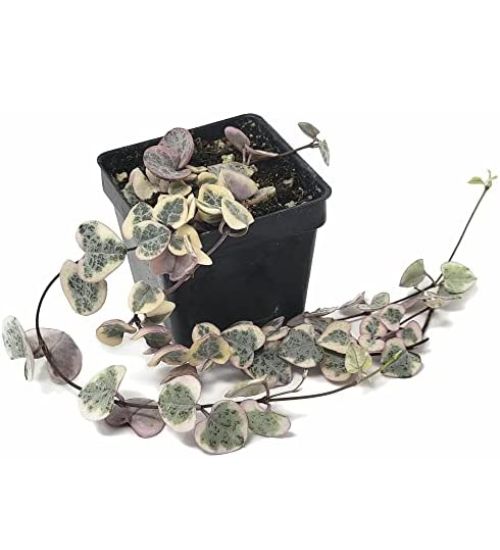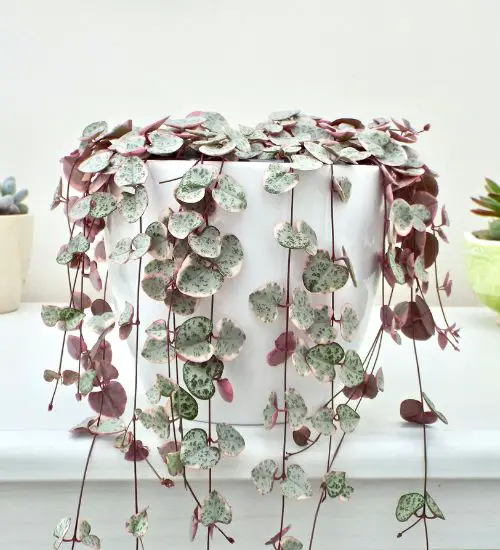Sun: Bright indoor light
Water: Typical water needs for a succulent
Temperature: Zone 10a from 30° F to 35° F (-1.1 ° C to 1.7° C) to Zone 10b from 35° F to 40° F (1.7° C to 4.4° C)
Winter Survival: Not cold hardy
Propagation: leaves, cuttings, seeds, tuber
Flower: in the summer and fall
Flower Type: pink, purple
Toxic: Generally non-toxic to humans and animals
Dormant: winter
Space Requirement: Indoors & Outdoors
Common Problems: Plants may rot if overwatered, pests
Basc Care for Cereopegia woodii, variegated
Watering
Watering for Cereopegia woodii, variegated is a simple task. It requires Typical water needs for a succulent.
What you need to remember is that this type of succulents needs to be watered for every 2 weeks
Fertilizing
Only feed this succulent during its active growing seasons which means Unknown - Tell us. Use the right fertilizer applied in the right amounts. Applying half-strength balanced fertilizer every month or so is recommended for optimal results.
Do not fertilize during winter as the plant is dormant.
Sun & Location Requirements for "String of hearts, rosary vine, chain of hearts, sweetheart vine"
Succulents need plenty of bright, indirect light. Your Cereopegia woodii, variegated is no exception! In order to thrive, "String of hearts, rosary vine, chain of hearts, sweetheart vine" needs to be in a spot that gets direct sunlight for at least part of the day. If you don't have access to natural sunlight indoors, consider investing in an LED grow-light or other artificial lights to mimic sunlight.
As per this succulent profile, it is only able to stay healthy when the environment temperature is above the range of zone 10a from 30° F to 35° F (-1.1 ° C to 1.7° C).
When temperatures drop below freezing, it is important to take precautions to protect Cereopegia woodii, variegated from the cold. Insulating and providing adequate drainage for the plant are key elements in helping it survive winter weather. Wind and sun exposure should also be minimized to prevent frost damage.
Any succulents in the group will need a medium space to grow. You can place your pot at your table or window. Since this plant needs more space than mini succulents, you should consider do not plant them together with other succulents/plants.
Cereopegia woodii, variegated also benefits from some indirect light throughout the day as well, so make sure you give it enough space to soak up light without becoming too exposed to heat.
Propagation
Propagating succulents by leaves is a great way to grow new plants from existing ones. Simply cut off a few healthy leaves from the mother plant and place them on top of a potting mix. Water the soil regularly, keeping it moist but not soggy, and soon you'll have brand new succulents!
One way to propagate Cereopegia woodii, variegated is by cutting
Cereopegia woodii, variegated can be propagated from seeds. Signs of a good seed is one that is plump, dark in color and slightly sticky. To propagate X from seed, one must prepare a soil mixture of well-draining potting mix, sow the seeds evenly and lightly press them into the surface. Lastly, gently water the soil using a spray bottle and place the container in bright but indirect light.
You can propagate Cereopegia woodii, variegated by tuber. To do so, start by gently removing the existing plants from their pot or container and carefully examine the roots. Select healthy-looking tubers that have no signs of damage or rot to use for propagation.
Toxicity

Cereopegia woodii, variegated is generally non-toxic to humans and animals. However, the plant may contain certain toxins which can cause mild skin irritation if it is ingested or comes in contact with skin. Therefore, it is important to keep the plant away from children and pets for safety reasons.
Pests and Diseases
Cereopegia woodii, variegated can be affected common pests and diseases like most of the other succulents such as aphids, mealybugs, and scale insects.
If you do spot any of pest signs, you can treat your succulent using below methods.
- Aphids: quarantine, clean infected plants, soapy water.
- Mealybugs: quarantine, clean infected plants, soapy water.
- Scale insects: quarantine, clean infected plants, soapy water.
Besides that, to prevent serious health issues from happening, keep your succulent in a well-ventilated area and check it regularly for any signs of pests or health problems.


